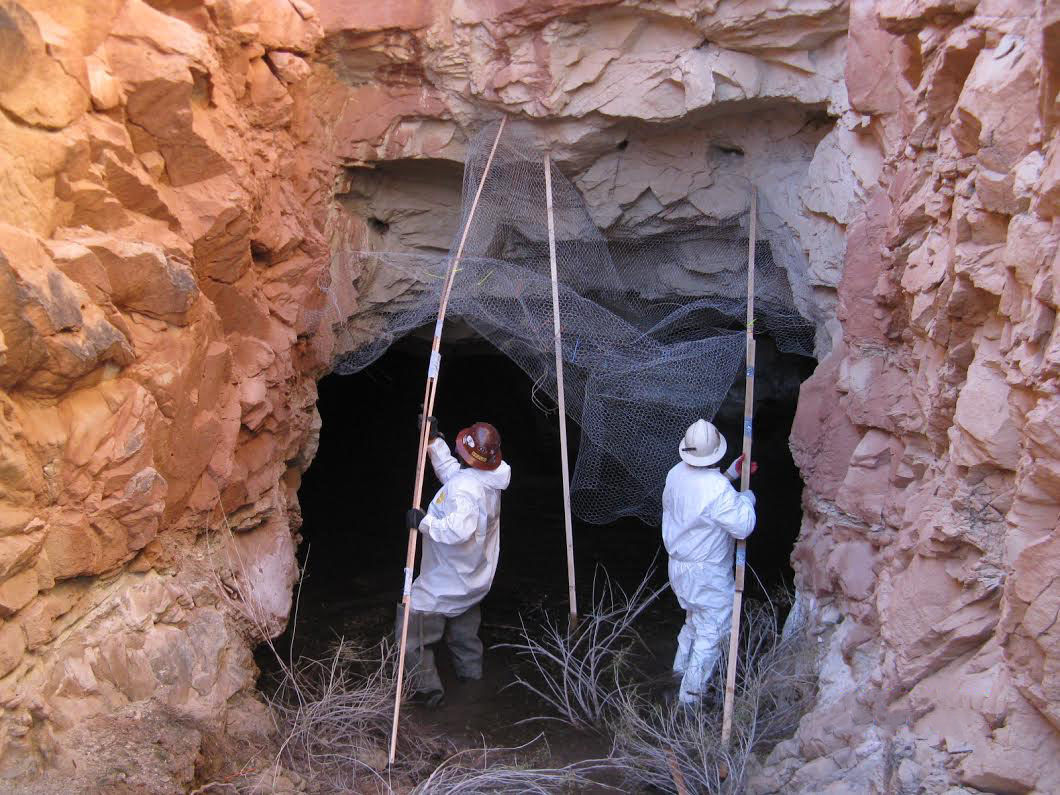The Utah Division of Oil, Gas and Mining’s Abandoned Mine Reclamation Program permanently closed 17 abandoned mines last month near popular Jeep and mountain biking trails in the Klondike Bluffs area north of Moab. The 11 uranium mines and six copper mines are all located on lands administered by the U.S. Bureau of Land Management (BLM).
“These mines were closed to protect public safety,” Utah Division of Oil, Gas and Mining (DOGM) project manager Susan White said. “People are intrigued by mine openings and often want to explore inside. These old mines contain dangerous gases and unstable structures.”
There is a nationwide campaign to close hazardous abandoned mines, White said. Mine closures are prioritized – such as those in the Klondike Bluffs area – in part, due to high levels of radon emissions from uranium mining. Radon is the second leading cause of lung cancer in the United States, according to the National Cancer Institute.
“(In) one of the mines, we saw a blanket inside, indicating that someone spent the night,” White said. “We backfilled that mine.”
The uranium mines are located near a popular Jeep and mountain biking trail in the Klondike Bluffs area about 12 miles north of Moab, and one mile from Arches National Park. The copper mines are in the North Klondike Bluffs area near the Baby Steps trail.
Moab Trails Alliance Executive Director Kim Schappert recalled that she and former BLM recreation planner Russ von Koch discovered an old mine 12 years ago, while scouting for the trail.
“It was going to be the first singletrack mountain bike trail on BLM land,” Schappert said. “It’s why we called it Baby Steps.”
Schappert said it was fascinating to see a lot of the old mining equipment lying around.
“It’s interesting it took so long to close the mines, and that there have been no mishaps,” Schappert said. “A lot of people knew about it.”
Federal agencies realize people are curious about the historic sites, White said. The directive to close the mines came due to their proximity to people hiking, biking and camping in the area, she said.
“One shaft in the area is a couple hundred feet off a bike trail – that’s why the BLM wanted it closed,” White said.
There have been 17 deaths associated with abandoned mines in Utah since 1953. People have died while exploring old mining sites when the mines collapsed, or they have fallen into shafts.
The Division of Oil, Gas and Mining has closed thousands of abandoned mines throughout Utah. White estimates there are 10,000 abandoned mines remaining in the state, including several in the Moab area, east of U.S. Highway 191, and south of Interstate 70.
“There’s a lot of work to be done,” White said. “Some are more dangerous than others.”
Construction crews used iron grates, polyurethane foam, concrete and soil to close the mines that often end up being habitat for bats. A week before some mines were closed, chicken wire was installed, allowing bats to crawl out, but not fly back in, White said.
Jessica Montcalm, project manager and archaeologist for an abandoned mine program that the Office of Surface Mining, Reclamation and Enforcement established in the 1970s, said she finds the old mines interesting. Federal agencies seek to protect public safety while also preserving historical sites, Montcalm said.
Copper mining in southeastern Utah is particularly interesting because of its remoteness, Montcalm said. Miners shipped the ore to Denver for processing via the railroad – an enormous investment at that time, she said.
Some of the old mines might qualify for designation as a historic register site due to the wood cribbing used to stabilize the opening when men were working in them. Miners hauled massive pieces of timber from long distances to stabilize the mines. In some cases, closures have been recessed two feet into the ground so that people can look at the interesting woodwork around the rim.
“We assess the historic cultural resources on the ground,” Montcalm said. “The National Historic Preservation Act guides us how we explore resources.”
Montcalm said she has found artifacts dating back to the turn of the 20th century.
“Moab has a unique mining heritage,” Montcalm said. “Moab grew because of mining. Uranium put the town on the map – it’s special to the area. We like to do what we can (to preserve) visual reminders of that heritage.”
The majority of the money spent on reclamation is directed toward cleanup of coal mining in the eastern United States. In the West, uranium is an issue due to the push for development during World War II, up until the 1970s, when government subsidies for uranium mining ended, White said.
Construction costs to close the mines near Moab totaled $45,000, excluding administrative costs to inventory the areas and then prepare bids for the work, White said. The BLM paid for the reclamation, as mine owners were not required to post reclamation bonds 50 years ago, she said.
Officials say work protects public safety, while preserving history
People are intrigued by mine openings and often want to explore inside. These old mines contain dangerous gases and unstable structures.




